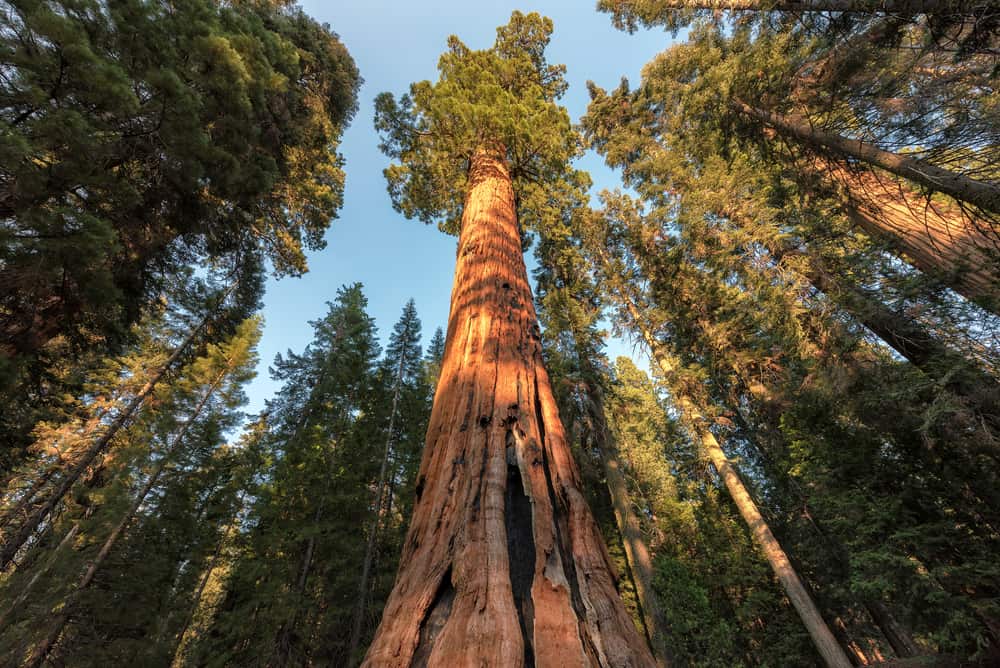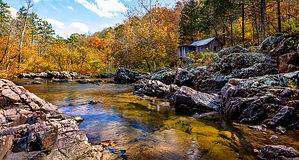Trees are incredible plants that are vital to the well-being of the planet. They play many important roles in ecosystems all around the world. Some of the most important ways that trees support life on earth are by turning carbon dioxide into oxygen, storing water, stabilizing soil, and providing habitat for wildlife. There are around 73,000 species of trees living around the world. The rarest trees in the world are all fascinating and unique species. The list includes some of the oldest trees on earth, as well as the largest. This article explores the 18 rarest tree species.
First, what is a rare tree? A rare tree species is one with few living trees. All of the rarest trees in the world are endangered species according to the International Union for Conservation of Nature (IUCN). The IUCN is an organization that collects and analyzes data about animals, plants, and fungi. This article uses IUCN conservation status to determine which trees are the rarest. All of the trees on this list are either critically endangered or endangered. Additionally, many of the trees on this list are endemic species, which means that they only grow wild in one specific place. Endemic species are especially vulnerable to extinction because they depend on a small range of habitats.
This list of the rarest trees includes some incredible species, including some of the oldest and tallest trees on Earth.
The 18 Rarest Trees in the World
1. Three Kings Kaikōmako (Pennantia baylisiana)

There is only one mature Three Kings Kaikōmako tree alive today, making it the rarest tree in the world.
©Molly NZ/Shutterstock.com
The rarest tree in the world is the Three Kings Kaikōmako. It is endemic to the Manawatāwhi Islands, also known as the Three Kings Islands, of New Zealand. Three Kings Kaikōmako trees nearly went extinct after humans introduced goats to the islands that they live on. The goats ate all but one lonely tree, too high up on a rocky cliff for the animals to reach. This one individual was the only Three Kings Kaikōmako tree left alive when the species was discovered in 1945.
Since then, scientists have propagated new trees from cuttings and even induced one to self-pollinate. Now, new Three Kings Kaikōmako trees can grow from the seeds of the self-pollinating individual. These trees are then able to set their own seeds. Scientists are planting these seeds around the Manawatāwhi Islands with hopes of re-growing the population. It will take between six and ten years for these new trees to grow large enough to flower. The restoration project will continue until there are at least 500 Three Kings Kaikōmako trees thriving in the wild. For now, the species is listed as critically endangered by the IUCN.
Physical Description
Three Kings Kaikōmako trees are small and shrub-like, with multiple trunks. They grow to be 16-26 feet tall. The leaves are oval-shaped and alternate. Notably, Three Kings Kaikōmako leaves tend to curl up on the sides.
2. Bastard Gumwood (Commidendrum rotundifolium)
Bastard gumwood trees are endemic to Saint Helena, Ascension, and Tristan da Cunha. Saint Helena, Ascension, and Tristan da Cunha are islands in the Atlantic Ocean, between South America and Africa. The islands are British Overseas Territories. When British people first arrived at these islands, gumwood trees were abundant. However, as the British East India Company began to settle the islands, settlers cut down many of the trees for fuel. Bastard gumwood trees were thought to possibly be extinct until a living tree was discovered in 2009. Conservationists are working to recover the species by growing seedlings. As of today, bastard gumwood trees are still listed as critically endangered by the IUCN. According to the IUCN Red List, there is only one mature bastard gumwood tree in the wild.
Interestingly, gumwood trees are a close relative of sunflowers. Gumwoods are the only trees that live in Saint Helena, Ascension, and Tristan da Cunha. These rare trees are thought to have evolved from sunflowers, which grew larger because they had no tree species to compete with for sunlight.
Physical Description
Bastard gumwood trees are small, growing to only 10 feet tall. The trees have white flower clusters.
3. Qiaojia Pine (Pinus squamata)
The Qiaojia pine tree is native to the Yunnan province of China. These trees only exist in Qiaojia county of Yunnan, on the border of the Sichuan province. The Qiaojia pine is the rarest species of pine tree in the world. Qiaojia pine trees were first discovered by scientists in 1991. Unlike many of the rarest trees in the world, this species is naturally rare. There is no evidence of any historical population reduction, and the population is not in decline today. However, the species is still listed as critically endangered by the IUCN due to its small population. According to the IUCN Red List, there are only 18-20 mature Qiaojia pine trees in the wild.
Physical Description
Qiaojia Pine trees can grow to be around 100 feet tall. Their bark is pale green but darkens as they age. They have long needle leaves.
4. Perrier’s Baobab (Adansonia perrieri)
Baobab trees, the genus Adansonia, are native to mainland Africa, Madagascar, and Australia. There are eight species of Baobab trees, six of which are endemic to Madagascar. Perrier’s baobab is the rarest species of baobab tree in the world and one of the species endemic to Madagascar. According to the IUCN Red List, there are 152-250 mature Perrier’s baobab trees in the wild. These rare trees are at risk of extinction due to being cut down for charcoal or timber, or to clear land for mining. Perrier’s baobab is listed as critically endangered by the IUCN. Flora and Fauna International partners with Madagasikara Voakajy to plant Perrier’s baobab seedlings and protect them as they grow into mature trees.
Physical Description
Perrier’s baobab trees can grow to be around 100 feet tall. They produce large flowers that only bloom for less than 15 hours.
5. Clanwilliam Cedar (Widdringtonia wallichii)
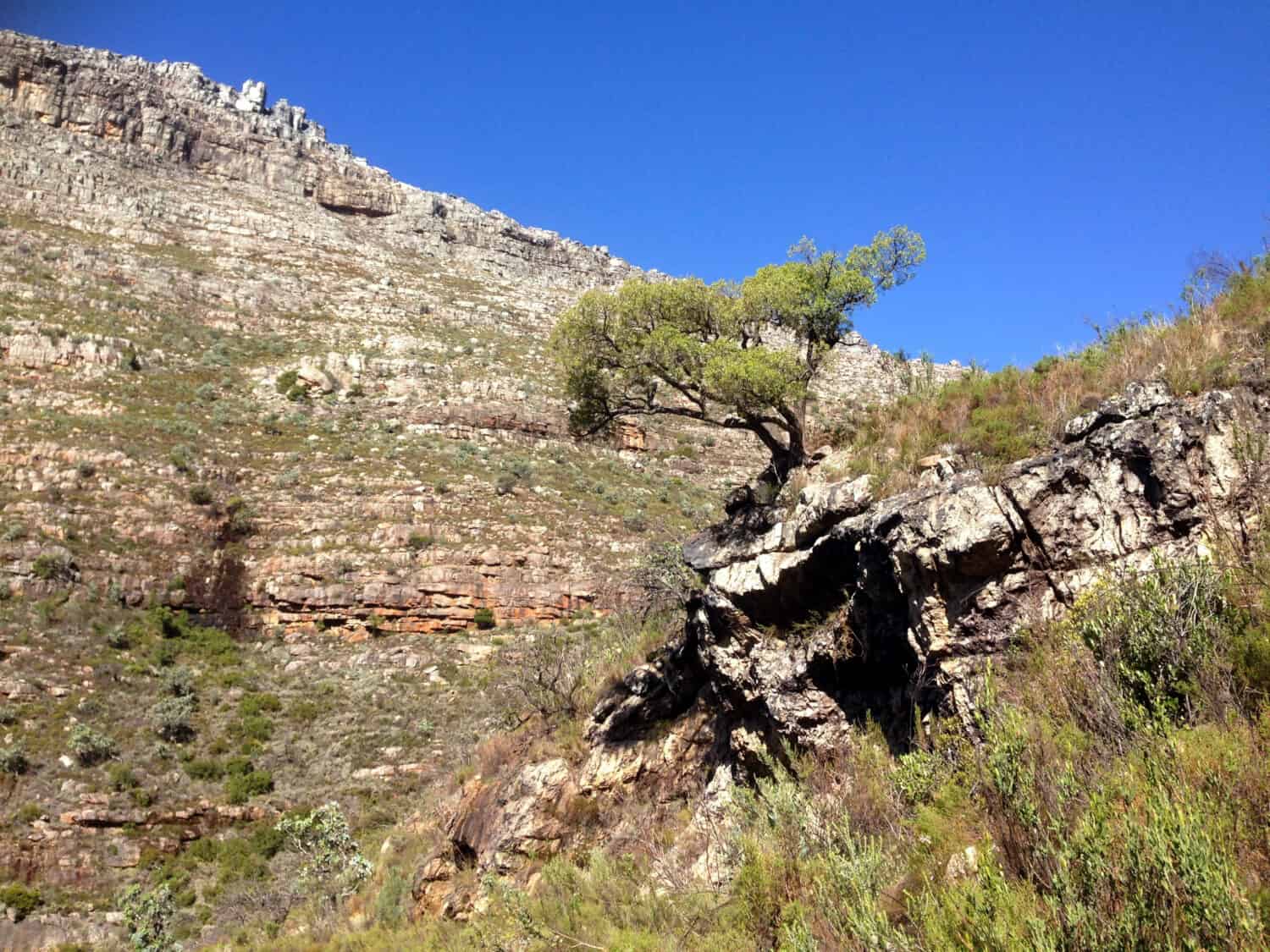
Clanwilliam cedar trees are also known as Clanwilliam cypress.
©A. Mertens/Shutterstock.com
The Clanwilliam cedar, or Clanwilliam cypress, is endemic to the Cederberg Mountains of South Africa. Clanwilliam cedars are experiencing population decline due to habitat loss. The South African National Forest Act protects these rare trees. However, Clanwilliam cedar trees remain critically endangered according to the IUCN.
Physical Description
Clanwilliam cedars are small trees, growing between 16-23 feet tall. The leaves are scale-like and opposite.
6. Waianae Range Pritchardia (Pritchardia kaalae)

Waianae Range pritchardia trees are facing habitat loss in their native Hawai’i.
©mozrid/Shutterstock.com
The Waianae Range pritchardia is a species of palm tree endemic to the island of O’ahu in Hawai’i. According to the IUCN Red List, there are 200 mature Waianae Range pritchardia trees living today. Waianae Range pritchardia trees face habitat loss due to feral pigs, cattle grazing, competition with non-native plants, and military activity. Today, Waianae Range pritchardias are critically endangered according to the IUCN. The United States Fish and Wildlife Service (FWS) has a recovery plan to conserve the existing Waianae Range pritchardia trees and recover the population.
Physical Description
Waianae Range pritchardias grow to be around 25 feet tall. Their trunks are around 1 foot in diameter. The leaves of the Waianae Range pritchardia are fan-like, which is typical of palm species.
7. ʻAlaʻalahua/Māhoe (Alectryon macrococcus)
Māhoe trees are endemic to Hawaii. The Māhoe trees are experiencing habitat loss due to feral pigs, cattle grazing, and competition with non-native plants. Māhoe trees are also at risk from the black twig borer (Xylosandrus compactus), a beetle that bores into the trees to lay eggs. According to the IUCN, ʻAlaʻalahua/Māhoe trees are critically endangered. The United States Fish and Wildlife Service (FWS) has a recovery plan to conserve the existing Māhoe trees and recover the population.
Physical Description
Māhoe trees can grow up to 36 feet tall. Their leaves are oval-shaped, and they produce fruit.
8. Florida Yew (Taxus floridana)
The Florida yew is a yew tree endemic to northern Florida, east of the Apalachicola River. Interestingly, Florida yew trees are a glacial relict. This means that these trees are suited to colder weather, and they were left behind as the last ice age receded. Florida yew populations initially declined from logging and development. Today, one of their main threats is deer rubbing and browsing. Additionally, these trees are not regenerating, and scientists do not yet know why. Florida yew populations are protected in Torreya State Park and the Apalachicola Bluffs and Ravines Preserve.
Physical Description
Florida yews are small conifer trees, growing between 20-32 feet tall. Their bark is purple-brown and scaly. The needles are thin and flat.
9. Florida Torreya (Torreya taxifolia)
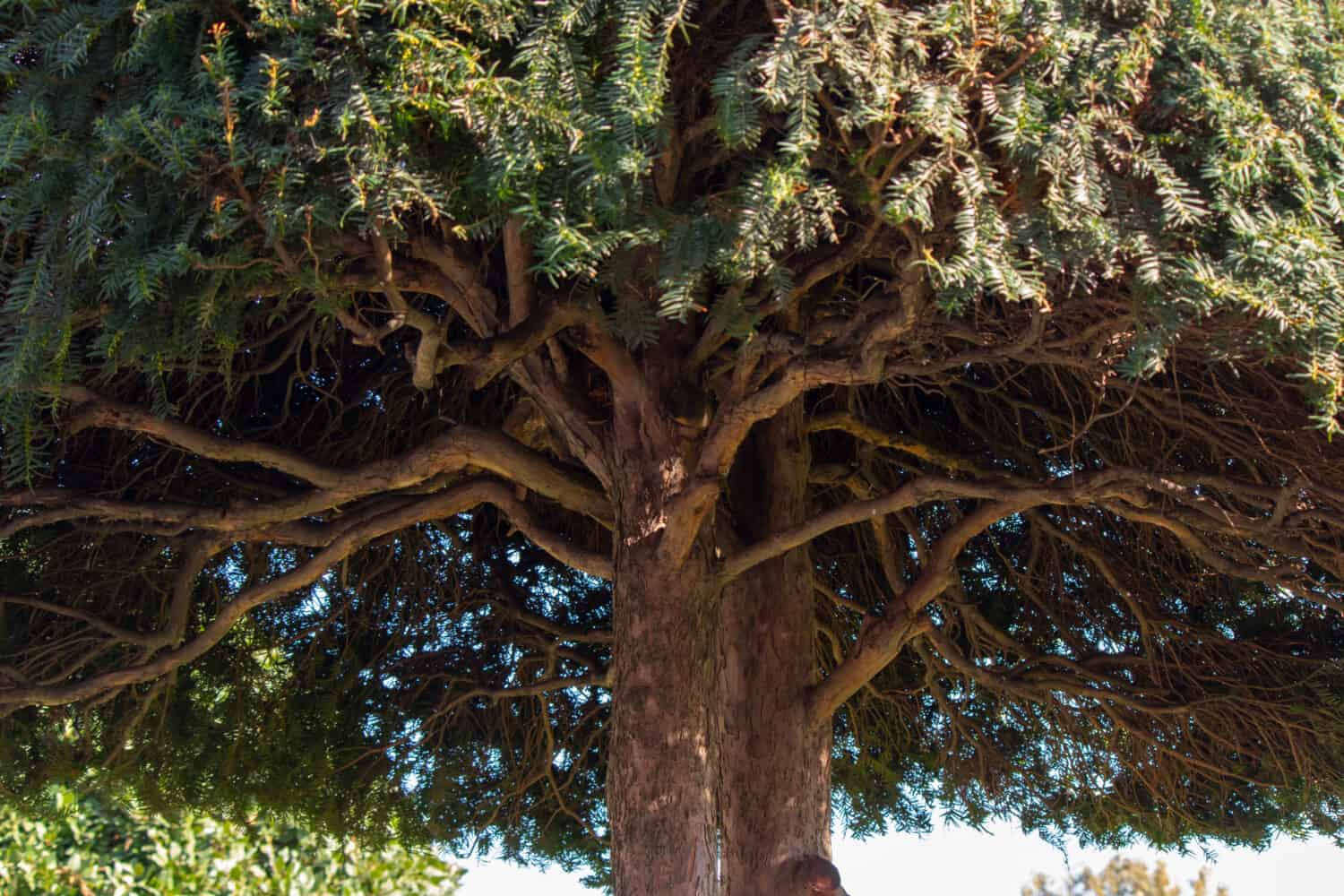
Florida torreya trees are also called stinking-cedar because of the smell of the bark.
©NMTD MEDIA/Shutterstock.com
The Florida torreya is a yew tree endemic to northern Florida and southeastern Georgia. Like the Florida yew, Florida torreya trees are also a glacial relict. The Florida torreya population initially declined when all of the reproductive-age individuals died around the same time. Today, the population is struggling to grow back due to deer browsing, fungal disease, and changes in the forest structure. Additionally, Hurricane Michael, a Category 5 hurricane in 2018, caused significant damage to the Florida torreya population. According to the Center for Plant Conservation, Florida torreya is one of the rarest species of coniferous trees in the world. Florida torreya trees are listed as critically endangered by the IUCN. According to the IUCN, there are 999 mature Florida torreya trees living today.
Physical Description
Florida torreyas can grow up to 60 feet tall. The branches are whorled. Florida torreya leaves are needle-like.
10. Honduras Rosewood (Dalbergia stevensonii)
The Honduras rosewood tree is native to Central America. Interestingly, this tree is actually in the legume, or bean, family. Honduras rosewood trees are rare because they only grow in a very specific habitat and because they are logged. Efforts to conserve these trees have some big challenges to overcome. Illegal logging of Honduras rosewood trees is common, and conservation workers face the threat of violence from people seeking to log the trees. According to the IUCN, the Honduras rosewood tree is critically endangered.
Physical Description
Honduras rosewood can grow 50-100 feet tall. The leaves are elliptical-shaped.
11. Canary Islands Dragon Tree (Dracaena draco)

Canary Island dragon trees face extinction due to habitat loss.
©Wirestock Creators/Shutterstock.com
The Canary Islands dragon tree is native to the Iberian Peninsula and western Africa. Specifically, this tree is found in Morocco, Madeira, the Canary Islands, and Cape Verde. The Canary Islands dragon tree is in the genus Dracaena, of which there are 120 species of trees and shrubs. Canary Island dragon trees are threatened by development, agriculture, and invasive species. According to the IUCN, the Canary Island dragon tree is endangered.
Physical Description
Canary Islands dragon trees can grow to 50 feet tall. They have one large trunk that splits into many branches. Their leaves resemble palm tree leaves, they are long-flat, and pointy.
12. Monkey Puzzle (Araucaria araucana)
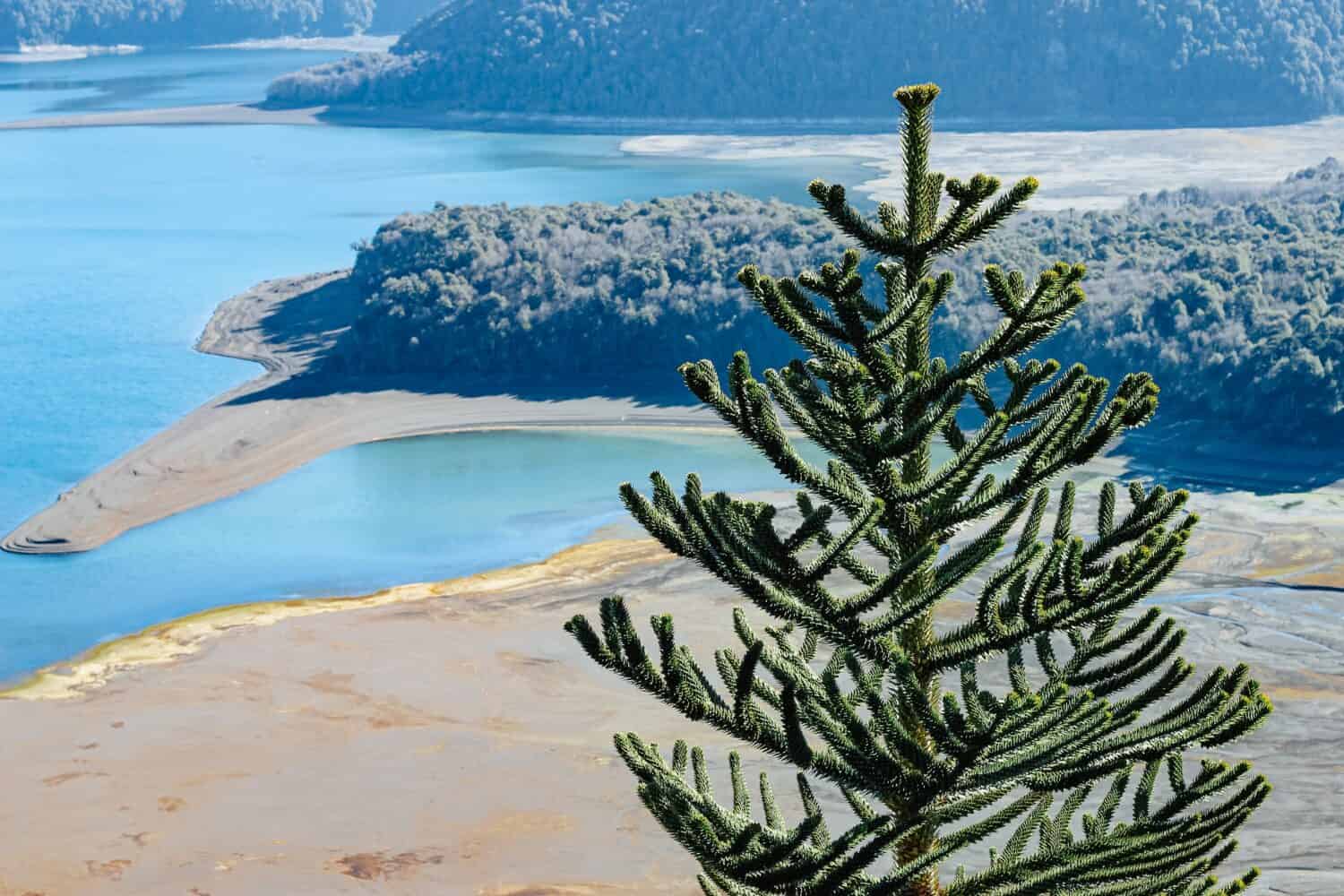
Monkey puzzle trees are named because their sharp leaves make them difficult to climb.
©Karen de la Paz/Shutterstock.com
The monkey puzzle tree is a conifer species, meaning it makes cones for reproduction. Monkey puzzle trees are native to Chile and Argentina. The biggest threats that monkey puzzle trees face are animal grazing, logging, and wildfires. In order to regrow the species, the Global Trees Campaign planted 2000 monkey puzzle trees. 90 percent of those trees lived to be ten years old. According to the IUCN, monkey puzzle trees are endangered.
Physical Description
Monkey puzzles grow between 98-130 feet tall. Their leaves are thick and pointy, completely covering the branches.
13. African Blackwood (Dalbergia melanoxylon)
The African blackwood tree is native to a wide range of Africa. It is in the legume, or bean, family. The African blackwood tree is in the same genus as the Honduras rosewood tree, Dalbergia. The wood of African blackwood trees is highly valuable, and the species is primarily threatened by logging. African blackwood trees have very low germination rates, so growing back the population is a slow process. Additionally, African blackwood trees take about 60 years to mature. Several organizations work to protect and regrow these rare trees. These include the African Blackwood Conservation Project and the Mpingo Conservation and Development Institute. According to the IUCN, African blackwood trees are endangered.
Physical Description
African blackwood trees are small, growing only between 13-50 feet. The tree has round leaves and clusters of white flowers.
14. Maple-Leaf Oak (Quercus acerifolia)
The maple-leaf oak tree is endemic to the Ouachita Mountains of Arkansas. According to the IUCN Red List, the maple-leaf oak tree is only found in three locations today. Maple-leaf oak trees face threats from habitat loss due to development, agriculture, and mining. According to the IUCN, maple-leaf oak trees are endangered.
Physical Description
Maple-leaf oak trees get their name from their leaves, which look like maple leaves. They can grow up to 50 feet tall.
15. Coast Redwood (Sequoia sempervirens)
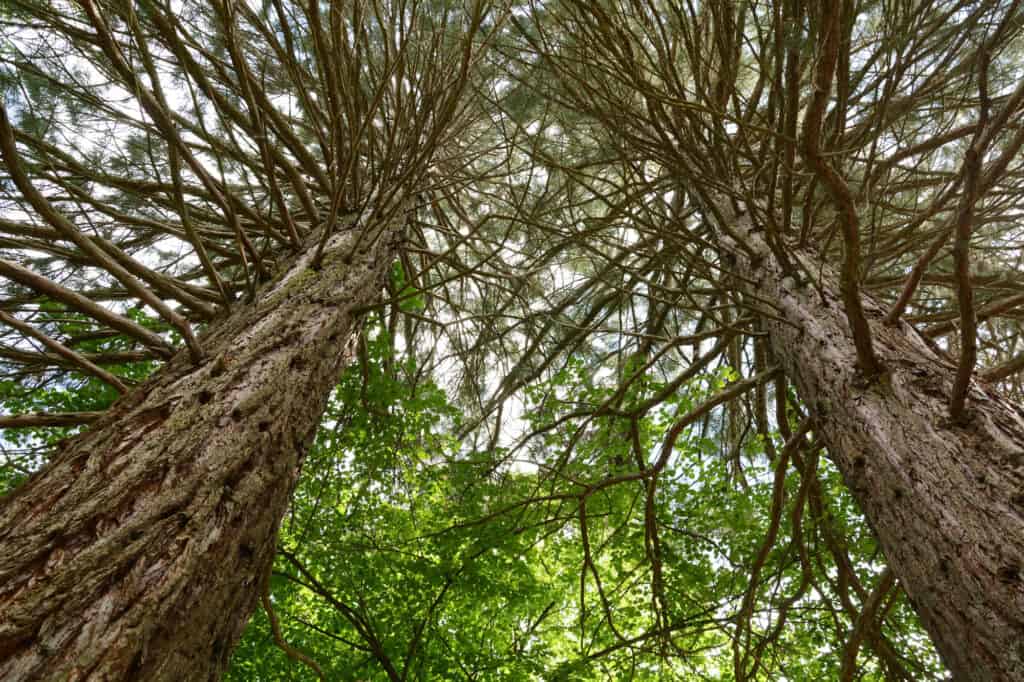
Coast redwoods are some of the oldest trees in the world.
©Greens and Blues/Shutterstock.com
The coast redwood tree is native to the Pacific coast of the United States, ranging from the central coast of California to the southern Oregon coast. It is the only living species of the genus Sequoia. These trees are known for living to be extremely old. They are one of the longest-living species on Earth. Some trees can even live to be more than 2,000 years old. Coast redwoods are also the tallest trees in the world. All of the tallest coast redwood trees are in Redwood National Park in California. The tallest tree in the world is Hyperion, a coast redwood that stands at 380.3 feet tall. Additionally, Hyperion is nearly 16 feet wide. Coast redwoods are protected in many federal and state parks in California. However, they still face the threat of wildfires. According to the IUCN, coast redwood trees are endangered.
Physical Description
Coast redwoods can grow up to 340 feet tall and 30 feet in diameter. Their bark is reddish-brown, giving them the name redwood. The long trunks of coast redwoods grow straight upward.
16. Giant Sequoia (Sequoiadendron giganteum)

The giant sequoia is the only extant species in the Sequoiadendron genus.
©arkanto/Shutterstock.com
The giant sequoia tree is native to the Sierra Nevada mountain range of California. Giant sequoias are the most massive tree species alive today. They also are one of the longest-living tree species in the world. The largest living giant sequoia is General Sherman, which is 275 feet tall and over 36 feet in diameter. General Sherman is also an incredibly old tree, estimated to be between 2,300 to 2,700 years old. Giant sequoia trees face threats from wildfire, drought, and human encroachment. According to the IUCN, giant sequoia trees are endangered.
Physical Description
Giant sequoia trees can grow up to 310 feet tall and 29 feet in diameter. Their appearance is similar to coast redwoods.
17. Longleaf Pine (Pinus palustris)
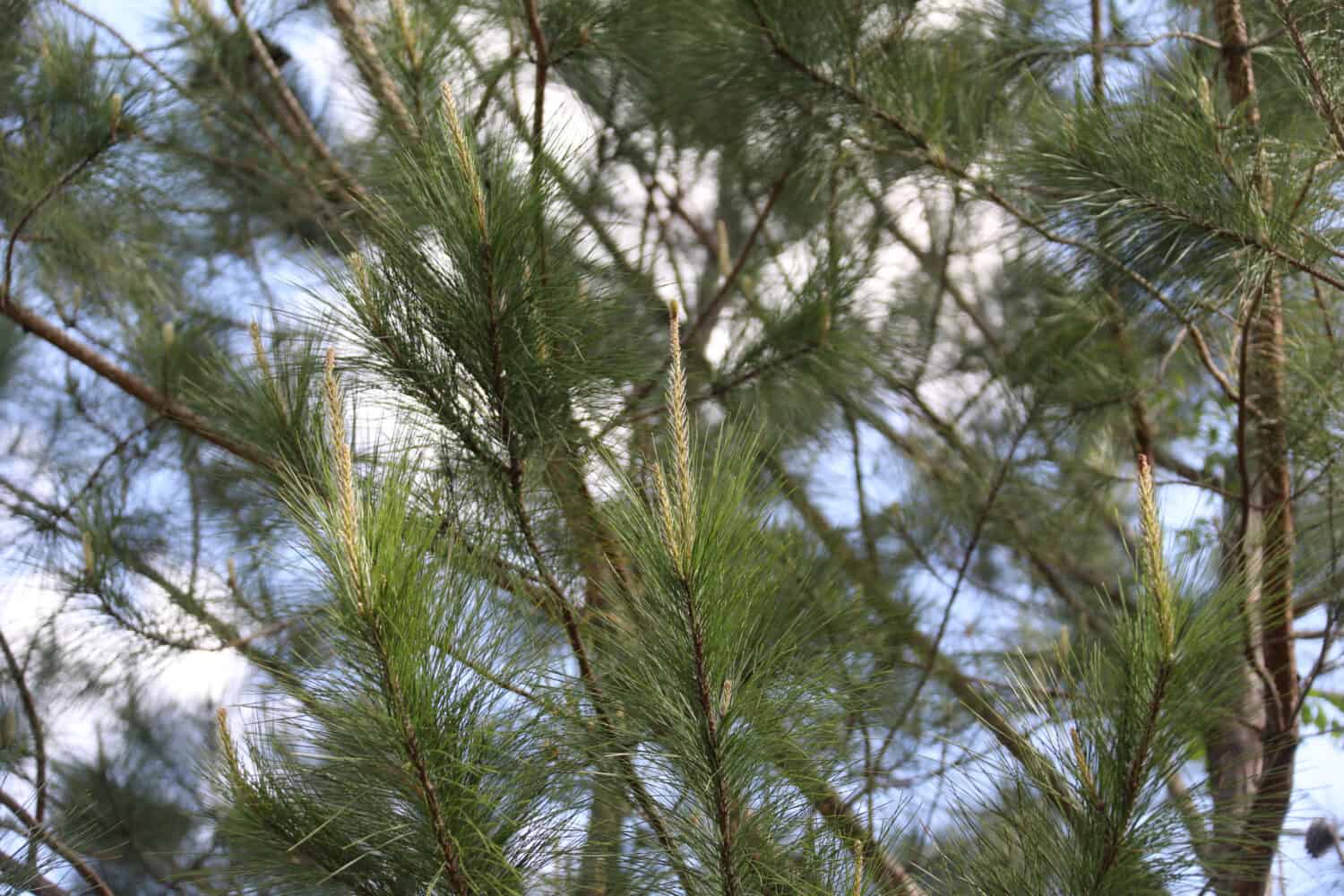
The population of Longleaf pine trees has been reduced due to logging.
©Natalya Chernyavskaya/Shutterstock.com
The longleaf pine tree is a species of pine tree native to the southeastern U.S. Longleaf pine trees were once widespread in the southeastern U.S., but early European settlers drastically reduced their numbers. Before Europeans arrived, the southeast had around 90,000,000 acres of longleaf pine forest. Now, these trees only occupy 5 percent of that range. The primary reason for the drastic reduction of the longleaf pine population is logging. Additionally, early logging practices left debris that made these forests more vulnerable to fires. The Longleaf Alliance is an organization working on conservation and education about these rare trees. According to the IUCN, longleaf pine trees are endangered.
Physical Description
Longleaf pine trees can grow 98-115 feet tall. They have long needle leaves and brown scaly bark.
18. Fraser Fir (Abies fraseri)

Fraser fir trees grow in high elevations in the Appalachian mountains.
©ANGHI/Shutterstock.com
The Fraser fir tree is a coniferous tree native to the Appalachian Mountains. One of the largest threats these trees face is the Balsam woolly adelgid, an invasive insect. Balsam woolly adelgid infestation has killed over 80 percent of the mature Fraser fir trees. Conservationists are collecting Fraser fir seeds to try to save the species. According to the IUCN, Fraser fir trees are Endangered.
Physical Description
Fraser fir trees typically grow 30-50 feet tall but can reach up to 80 feet tall. They have needle leaves with a spiral pattern.
Summary of the 18 Rarest Trees in the World
| Rank | Species | IUCN Status | Number of Mature Individuals (IUCN) |
|---|---|---|---|
| 1 | Three Kings Kaikōmako (Pennantia baylisiana) | Critically Endangered | 1 |
| 2 | Bastard Gumwood (Commidendrum rotundifolium) | Critically Endangered | 1 |
| 3 | Qiaojia Pine (Pinus squamata) | Critically Endangered | 18-20 |
| 4 | Perrier’s Baobab (Adansonia perrieri) | Critically Endangered | 152-250 |
| 5 | Clanwilliam Cedar (Widdringtonia wallichii) | Critically Endangered | Unknown |
| 6 | Loulu Palm (Pritchardia kaalae) | Critically Endangered | 200 |
| 7 | ʻAlaʻalahua/Māhoe (Alectryon macrococcus) | Critically Endangered | Unknown |
| 8 | Florida Yew (Taxus floridana) | Critically Endangered | Unknown |
| 9 | Florida Torreya (Torreya taxifolia) | Critically Endangered | 999 |
| 10 | Honduras Rosewood (Dalbergia stevensonii) | Critically Endangered | Unknown |
| 11 | Canary Islands Dragon Tree (Dracaena draco) | Endangered | Unknown |
| 12 | Monkey Puzzle (Araucaria araucana) | Endangered | Unknown |
| 13 | African Blackwood (Dalbergia melanoxylon) | Endangered | Unknown |
| 14 | Maple-Leaf Oak (Quercus acerifolia) | Endangered | Unknown |
| 15 | Coast Redwood (Sequoia sempervirens) | Endangered | Unknown |
| 16 | Giant Sequoia (Sequoiadendron giganteum) | Endangered | Unknown |
| 17 | Longleaf Pine (Pinus palustris) | Endangered | Unknown |
| 18 | Fraser Fir (Abies fraseri) | Endangered | Unknown |
Thank you for reading! Have some feedback for us? Contact the AZ Animals editorial team.

